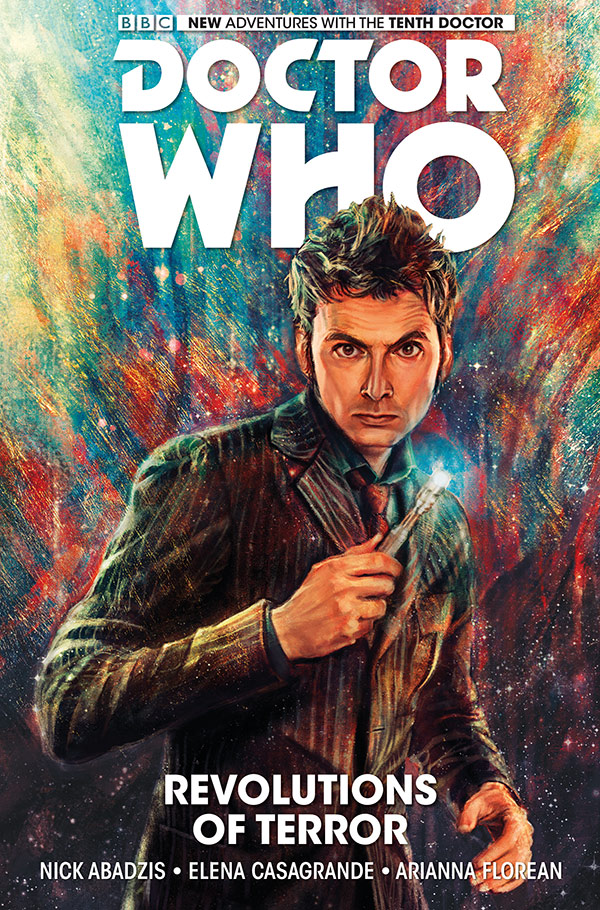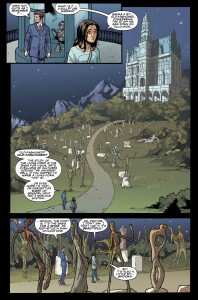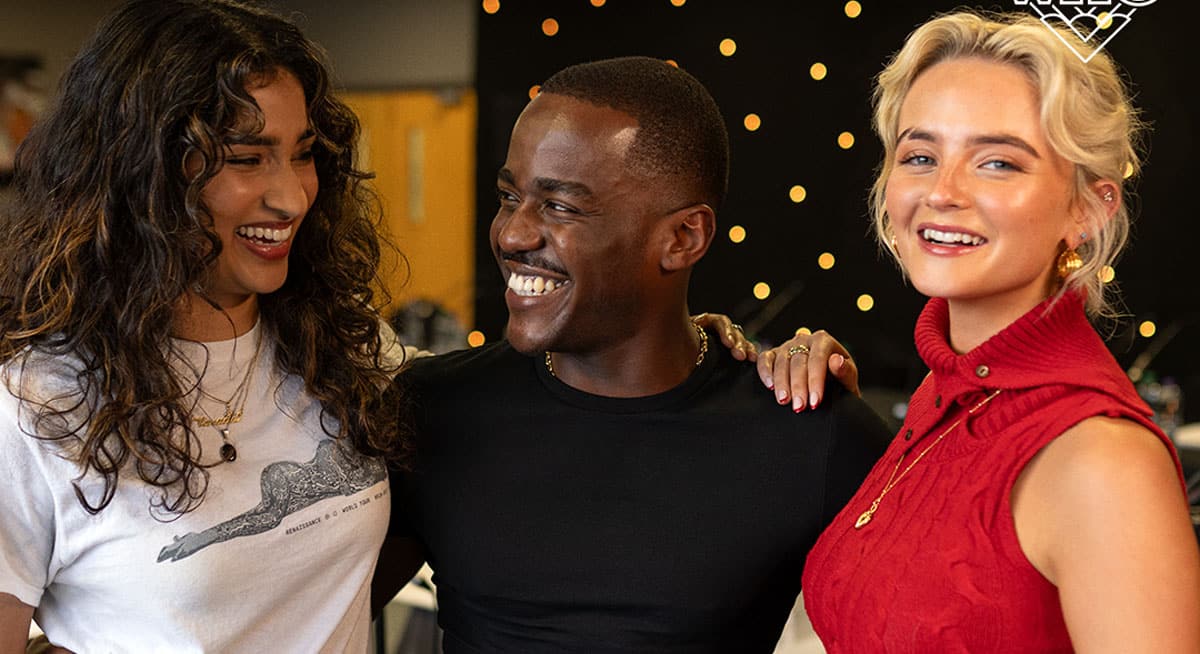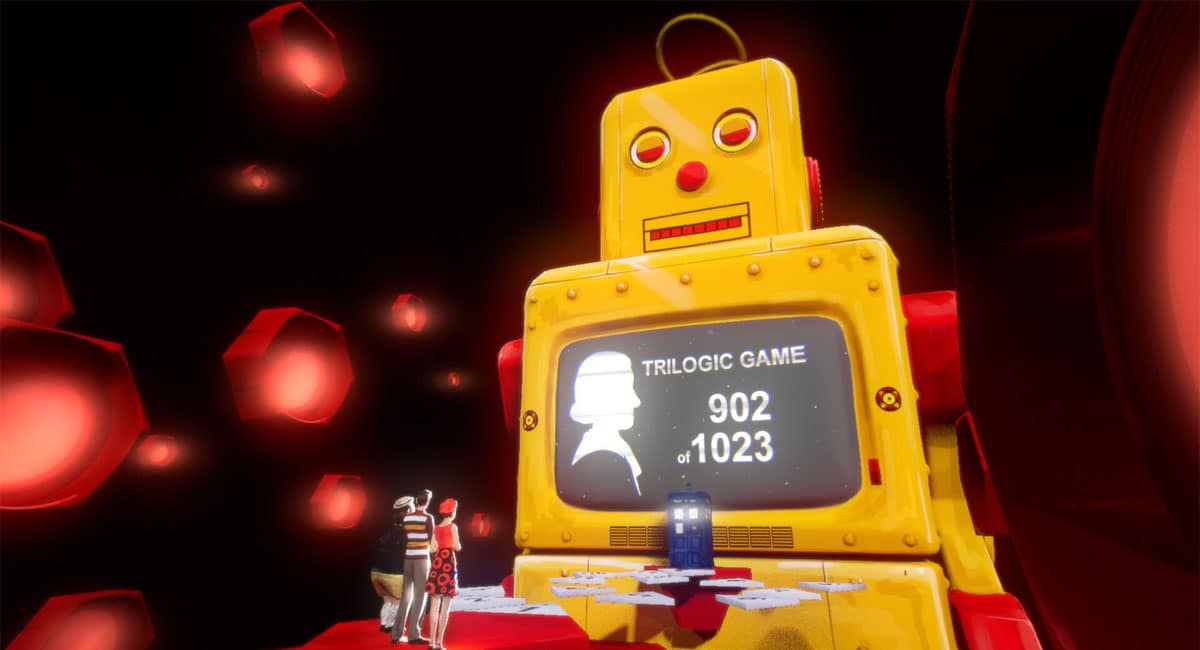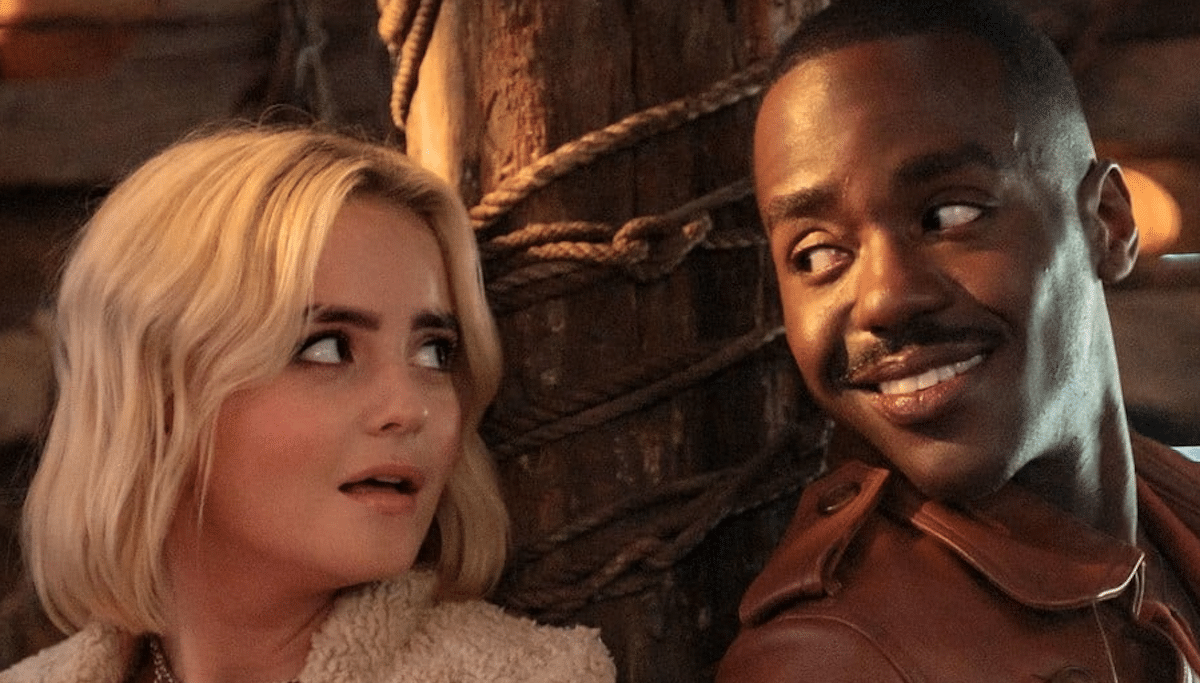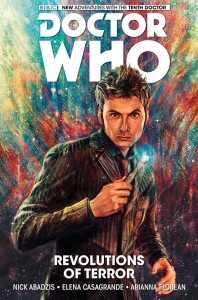
Edie Nugent: How did you decide where in the 10th Doctor’s timeline to begin the story?
Nick Abadzis: That was part of the brief [from Titan], but it made sense to me. No-one really knows how long the Doctor has lived, and there’s always potential for setting stories between TV episodes or seasons or any kind of gap, but that end of the tenth Doctor’s life is largely undocumented, so there’s even more room than usual.
Nugent: What made you choose the Sunset Park neighborhood in Brooklyn, NY as the setting for Revolutions of Terror?
Abadzis: Because the books were initially aimed at the US market (albeit all Who fans) it was suggested it could be an American companion. I’m British, but I live in New York, so automatically I wanted to set some stories here. I live in Brooklyn, next door to Sunset Park as a matter of fact, and I happened to be cycling around there while I was thinking about all this. It’s a very Mexican and Chinese area and it struck me that it would be a lot of fun to have the TARDIS materialize in the park there, with that fantastic view of the bay and Manhattan. The idea for Gabby Gonzalez as a companion and Cindy Wu as her best friend came shortly after – it all sort of grew from there.
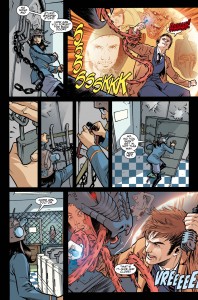
Abadzis: Thank you. I’ve lived here for just over five years now, but I go back a long way with this city. I first came here in the early eighties when I was a kid – my oldest friend is from Westchester County and eventually he moved into an apartment on the Upper West Side around 72nd St. and I visited him a lot as a teenager. So NYC has always been a big part of my personal mythology. See also my strip Hugo Tate from Deadline magazine.
The NY subway is overdue for an alien invasion, no? The London Underground had the second Doctor rooting out an infestation of Yeti down there. Cybermen on the F train – now, there’s a thought…
Nugent: So did the idea to set the story in Sunset Park come first, and lead to the development of Gabby Gonzalez as a companion? Or was it the other way around?
Abadzis: I think they occurred concurrently. Gabby assumed a character very, very rapidly in my mind… I was bouncing ideas at Andrew James, the Titan Comics Doctor Who editor, and Robbie Morrison, one of my co-writers, and once I had the idea for Gabby I really went for it; I really wanted to write this character, her family and friends. It all sort of cohered. When that happens, as a writer, as a storyteller, you listen to those instincts and you go for it.
Nugent: It’s so wonderful to see some real diversity in companions for the Doctor. What about Gabby stuck out to you most as first, that defined who she is? The kind of energy & dynamic she brings to the TARDIS?
Abadzis: There’s probably a lot of me in her – first generation, immigrant parents, their children are of the country they’re born into rather than the old one, but at the same time, to a certain extent, she’s bound by the constraints and expectations of family. She’s very open-minded, she wants to get out there and really live, experience things, so she chafes a bit at what’s expected of her. These are not uncommon traits; I’m sure they’re recognizable to many readers…
She’s also creative, she lives by her instincts as well as her intelligence (which is both emotional and intellectual) but, other than Turlough, a companion of the fifth Doctor’s, I’m not sure there’s been an artist per se onboard the TARDIS before. This seemed like a good way of availing ourselves of the language of comics and at the same time giving Gabby a distinctive voice, a way of recording all she sees and experiences.
Also of course, I must just say, once the initial character sketches started coming in from Elena… that just sealed it. Gabby was there. Elena had loads of little visual ideas about how to bring about these characteristics of Gabby’s, embed them in her visually and it was beautiful to see Gabby come alive. You should’ve seen all the work she put into trying out all these different hairstyles for her.
Nugent: Well, unless you count the brief Van Gogh trip to see his future art gallery, I can’t think of any TARDIS artists either. What you say about Elena’s art sealing the deal makes sense: Gabby feels like a very real person to me. The comment about her last name–Gonzalez—being used to taunt her on the playground by referring to the discontinued Loony Tunes character hit me right in the heart.
Abadzis: Doctor Who is about diversity in a way – if you dig, there’s been a lot of stories about intolerance in Doctor Who. The Daleks are essentially fascism personified.
Nugent: Oh yes, the Kaled’s from Genesis of the Daleks even wear the Hugo-Boss stye Nazi uniforms before they are turned by Davros to the Daleks we know and fear. I agree that Doctor Who often explores intolerance, but rarely have we seen it through the eyes of racially diverse companions.
Abadzis: True enough. Given that we had the opportunity to pick a companion from New York City, one of the most ethnically diverse cities in the world, she could’ve come from almost any background…
For a while I played with the idea of naming her “Gabriella Gomez.” I kept Gonzalez because I was aware of the discourse over the animated character. Also, Gabby is named (sort of) after a friend of mine, a real-life Mexican-American cartoonist and teacher, Gabrielle Gamboa. I always loved the way her name sounded, kinda reminded me of the LL thing in the Superman books – Los Lane, Lana Lang, if you see what I mean. Although I will probably refrain from naming other characters in a similar way.
Names of characters are important. I spend a lot of time getting that right.
Nugent: I really appreciated the inclusion of the song “Cielito Lindo” as a source of power. Looking at the lyrics it seems tailor-made for a Doctor Who alien invasion!
Abadzis: Like I say though, when I was cycling through Sunset Park, I saw potential Gabriellas everywhere – I imagined the TARDIS landing there, and if the Doctor came out, who would he meet? One of the locals. When a character feels like she created herself (I’m romanticizing it), you have to go with it.
Nugent: How did you decide where Gabby would travel to on her inaugural TARDIS trip?
Abadzis: She wants to be an artist (she already is, she just doesn’t know it) and she asked the Doctor to teach her… so he decides to take her to an art gallery. Not just any art gallery mind, because the Doctor is a show-off… he wants to take her somewhere impossibly glamorous too, so that’s why he picks Ouloumos. He has a history with the place (of course).
Nugent: It was great to see the 10th Doctor falling through those MC Escher staircases after name-checking that the artist they visit as having become and adept at Logopolis. Did Classic Who of that era influence how you decided to tell this story?
Abadzis: All that stuff, those classic episodes, are in my head, so yes. Can’t quite recall where the idea of a block-transfer sculptor came from precisely, but I just thought it’d be fun to have someone who was trained on Logopolis be able to use similar abilities in a creative way. It gets out of hand, inevitably.
Zhe (the artist) has known the Doctor at least since his fourth incarnation, as you can tell by the portrait of him and Romana II on her wall.
Nugent: Does that place the start of the Doctor’s friendship with Zhe during that era?
Abadzis: From that you can infer that the Doctor has known Zhe a long time – s/he certainly seems to be very long-lived and from this adventure and that painting, we know that at least two incarnations have known her – probably more. I’m sure she really dug the sixth Doctor’s coat and I can certainly imagine her sharing a cocktail or two with the eighth Doctor.
But as to when precisely it takes place…? “All of time and space, my dear, all of time and space…”
Nugent: You penned a story about the 10th Doctor and Rose for Doctor Who Magazine almost 10 years ago. What was it like returning to the same character at this point in his “song” (or maybe “Coda” would be more appropriate)?
Abadzis: Yes, that was strange… that was the tenth Doctor’s debut adventure in comics, and at the point that it was written, no-one knew what he was going to be like, how David Tennant would play him! I’d seen Tennant in things before, so I recall us basing his manner, his cadences a little bit on previous performances and also, fundamentally, it’s the Doctor, it’s the same man, so there are certain basics to his character that are common to all incarnations of the character.
It was really lovely to be asked to write him again… Of course, by this point, I knew everything about him, how he’d lived and regenerated, so I had a much better angle on how to approach it. In my mind, he’s still very much a living breathing character, his time has not ended, that song is still going strong. I think that’s the best way to approach it, because it makes the threats he comes across very real and all the more terrifying.
Time can be rewritten, don’t forget…
Nugent: The idea that a harsh critic can aid in transforming a creative spirit into a lethal monster is an interesting framework for a Who adversary, as is the fact that creatives can often be their own worst enemy; how did you decide on that idea?
Abadzis: It developed naturally out of the narrative. Originally, this was going to be a story about artists becoming subsumed into a wider, greater entertainment machine, about creatives servicing a voracious alien entity, but it was just too huge for two issues and, quite correctly, the BBC and Andrew, my editor, made me slim it down to something less epic. The element common to both versions was the block-transfer sculptor Zhe, who sounded like an interesting character, so I worked more on her. I had these very visual ideas about Giacometti-style sculptures coming to life and Elena drawing these and to a certain extent, when you get an idea like that, it suggests a story. And I was right, she did a great job there, with that whole sequence of the Doctor and Gabby’s journey up to Zhe’s mansion.
And Zhe is the ultimate artist in many ways – oversensitive, but full of empathy, creative but holding herself to high standards so that when she doesn’t meet them, she feels she’s failed. She’s kind of a reflection of the Doctor in some ways, which is probably why their friends – that, and he’s a real Renaissance man too, of course.
Nugent: How are you feeling about the recent news that your comic story line will merge with that of the eleventh and twelfth Doctors this fall in a limited series to be written by Hugo-nominated Doctor Who television writer (and longtime who fanboy) Paul Cornell?
Abadzis: I can’t answer for Elena, but I’m fine with that! I’ve read (and watched) Paul’s work for many, many years and he really is among the greats of Doctor Who writers in my opinion. He wrote Human Nature (which, if you haven’t read the original novel featuring the seventh Doctor, go buy it now)! Multi-Doctor stories are part of the tradition of Doctor Who and I get the idea they’re tough to write, but you are in extremely good hands with Paul Cornell. He’ll write a blinder.
Nugent: Are there any tantalizing story clues or tidbits you can share with our Comics Beat readers from the upcoming issues of the 10th Doctor?
Abadzis: Let’s see… we have a new “big bad” on the way, a being who isn’t deliberately out to get the Doctor but simply by virtue of his very powerful presence upsets a lot of things, keeps them out of balance. He’s not even a villain exactly, he’s a almost a victim of circumstances himself who is weary with the universe and this huge weight of responsibility he has upon his shoulders. When he encounters the Doctor, he sees a solution to his problems and wants the Doctor to help him. But it’s not the kind of help the Doctor is inclined to give…
Doctor Who: Revolutions of Terror is available in comic shops on March 25, in bookstores March 31. For more information on Gabrielle Gamboa, the inspiration for companion Gabby Gonzalez, check out Gamboa’s website: http://www.gabriellegamboa.com/


